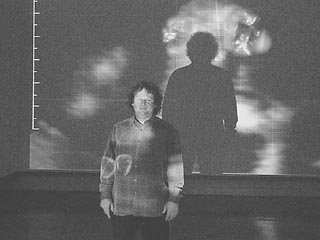 |
Garth Paine, Gestation |
Gestation is a playful work, using real time sound and vision generated from the movement patterns made by visitors within the installation. There are no mouse clicks here, only pure sonic viscerality. In an empty room, you wave your arms, move your elbow, run around, and the resulting sounds are like aliens breathing (thanks to software the artist has written which uses video sensing to translate light intensity onto sound algorithms). It’s a kinaesthetic experience, this ambient-generative sound space, turning the body into a forcefield of energy. And it doesn’t stop there: a secondary gallery displays a large video projection of real foetuses in the frame of an ultra-sound grid (from videos collected over 5 years, and animated by Kat Mew and Clint Hannaford). Enough dynamic visitor activity in the sound chamber generates ‘new’ foetuses.
How does Gestation fit into the context of your art practice?
There are 2 legs to my practice: the compositional work, less improvisatory and more considered in its forms, and the interactive installation works. I’m interested in contextualising new media in the human domain, and especially in placing the human body as the central ‘controller’ of the generation of any output. Furthermore, while I define certain aspects—the aesthetic and the general scope and functionality—the work creates an individualistic and momentary response. I’m interested in interactivity not as a triggered response of pre-made content, but in content made in real time, responding as streamed data, constantly changing according to the input it’s receiving from your behaviour.
In order for new media art to become culturally important, it has to reflect something about the human condition. And to be relevant enough to be collected into cultural institutions and have broad public exposure, the technology should be transparent (at international festivals of electronic arts you see a lot of technical feats without any point). Gestation is actually an explicitly humanist statement—it moves beyond the sense that your behaviour patterns are generative of your environment to those behaviours actually generating ‘new’ human life. It’s a statement about the connection between responsive and interactive work, and the human context in which it’s placed.
Is there also a connection to the ‘docile bodies’ produced by surveillance? After all, the work uses security camera technology.
No, there’s nothing recorded so there’s no capturing of the body for observation in another environment. I think of the body as the central ‘catalyst’ from the perspective that in our lives if we want to express something we use our body. Since sound is such an abstract and emotive form, I would hope that Gestation produces external and internal reflection; which is what I think art should do.
Are the sounds in Gestation entirely produced ‘on-the-fly’ in real time, or does it use samples?
The more recognisable—the baby giggle and breath—are generated from spectral analysis files of original sounds, resynthesised and reassembled for particular activity in the space. There’s a light level of evolutionary sound; a level of memory generates slight variations when it comes back to rest. A little movement of the arm creates a nuance that’s specifically yours.
I understand the work is not a commentary on technology and reproduction, so I’ll gloss over the sexual politics or any unintended foetus-fetishising in the act of viewing the ultrasounds. Nevertheless, it’s striking that unlike a lot of contemporary art, there’s no sense of your work trying to alienate the visitor—it’s a comforting, utopian space, dare I say pre-oedipal.
The sound chamber is supposed to be womb-like. The mind-body split is so embedded in our culture—their interrelationship is more interesting to me than deconstructing. Sound is the most wonderful and powerful medium in the sense that it’s fluid and viscous, so you sort of mould it. It’s about densities and textures, you can pull it apart, form it into shapes. I think of it as quite a physical, visual thing. And yet, rather than an image, a detached and abstract thing, the sound physically enters your body, it enters your ears and vibrates your organs. You are not separate from sound but totally immersed in the ‘fluid.’
Fluxus artists Earl Brown and Morton Feldman and others were interested in making their sound work very plastic, establishing a structure as a composer where every performance would be different. Similarly, I’m interested in getting out of the way, not imposing pre-made content on people, but creating a set of mappings that allow each person to generate their own performance—their own experience.
In Gestation, sound is the media of connection between the sound gallery and the video. With ultrasound, sound is applied as a way of visualising the otherwise invisible ‘information’. So in this case, the activities that create this audible environment in turn allow you to visualise the lifeform you’ve created in the second gallery.
Finally, what about your experience of being a sound artist in Melbourne?
I find it frustratingly impossible to get support for exhibiting here in Australia. There are the equipment challenges, and so on, but my works are exhibited overseas quite a bit. In 2002, Gestation will be shown at Florida State Art Gallery, and I have a show in Paris (people seem to tune in). We need a research centre that supports the exhibition of sound art and the development of techniques and approaches to sound art. Sound is the most innovative of the digital arts—an entirely new genre that can’t draw on the patterns that existed previously (it’s only since Cage that ‘found sound’ has become acceptable as a compositional object). We’ve had to find ways of exploring digital sound—textural density and so on—whereas in visual multimedia, the paradigms have continued within an essentially filmic model.
Gestation, Garth Paine, RMIT Gallery, Melbourne, December 10-21 . Garth has just been appointed Lecturer in Music Technology at De Montfort University in Leicester.
RealTime issue #47 Feb-March 2002 pg. 21
© Daniel Palmer; for permission to reproduce apply to [email protected]








 back
back